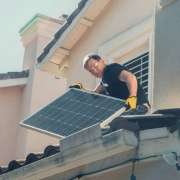Switching to solar power is a smart way to lower electricity costs, reduce your carbon footprint, and increase your home’s value—especially in California, where sunshine is abundant and incentives are available. If you’re considering residential solar panels in CA, here’s how to get started.
Assess Your Energy Needs
Before investing in solar panels, evaluate your household’s energy consumption. Check your electricity bills to get your average monthly usage. This helps you decide how many solar panels you’ll need.
Check Your Roof’s Suitability
Solar panels work best on roofs with good sun exposure. South-facing roofs with minimal shading from trees or buildings are ideal. If your roof isn’t suitable, consider ground-mounted solar panels as an alternative.
Understand Solar Incentives
Many governments and local utilities offer tax credits, rebates, and incentives to offset installation costs. Research available programs in your area to make your investment more affordable.
Choose the Right Solar System
There are three main types of solar systems:
- Grid-Tied: Connected to the power grid, allowing you to use solar energy and draw electricity from the grid when needed.
- Off-Grid: Completely independent, requiring battery storage for nighttime and cloudy days.
- Hybrid: Combines solar panels with battery storage while still being connected to the grid.Get Quotes from Solar Installers
Reach out to multiple solar companies for quotes and compare pricing, warranties, and customer reviews. A professional installer will assess your home, design a system, and handle the permitting process.
Consider Financing Options
Solar panels can be a big investment, but financing options like solar loans, leases, and power purchase agreements (PPAs) make it more accessible. Weigh the pros and cons of each option to determine what works best for you.
Schedule Installation
Once you’ve chosen an installer and secured financing, schedule the installation. Most solar panel installations take a day or two, but obtaining permits and approvals can take a few weeks.
Monitor and Maintain Your System
After installation, monitor your system’s performance through an app or monitoring service provided by your installer. Solar panels require minimal maintenance, but occasional cleaning and inspections will keep them running efficiently.
With rising electricity costs and some of the best solar incentives in the country, now is a great time to invest in residential solar panels in CA. By following these steps, you can make a smooth transition to solar energy and enjoy long-term savings while supporting a cleaner environment.

